Drone strikes: Rights groups berate US for not following its own rules
Loading...
| Washington
The US government has not been adhering to the drone-strike policy promised by President Obama in his closely-scrutinized speech at the National Defense University last May, in which he pledged that prior to any US attack “there must be a near-certainty that no civilians will be killed or injured – the highest standard we can set.”
That is the assessment of two investigations released Tuesday by Amnesty International and Human Rights Watch, who noted that it was a “significant” step for the two leading human rights groups to merge their efforts to produce the reports.
Since 2009, for example, the US government has carried out an estimated 80 drone strikes in Yemen, killing an estimated 473 people, according to the Human Rights Watch report.
In many cases, those killed were civilians whose deaths have gone unacknowledged, according to the two groups, who challenge the myth of the “antiseptic assault” and call the strikes violations of the laws of war that may amount to war crimes or even extra-judicial executions.
At the same time, the groups say they cannot definitively make these determinations because the US government has not acknowledged the killings or provided the accountability and transparency promised by Mr. Obama in his May foreign policy address.
What seems clear is that the United States “has acted like a hit-and-run driver, refusing to take responsibility” for the deaths of innocent civilians, argues Naureen Shah, a legal adviser to Amnesty International.
The White House has not replied to “numerous letters, e-mails, and telephone calls” from the organizations requesting data on the strikes, according to spokesmen who add that the two groups did each receive the same identical response from the Central Intelligence Agency, which referred their queries to the White House.
They pointed to specific instances of civilian deaths, including a drone strike in Pakistan in which 18 male laborers, including a teenage boy, were killed while eating their dinner after a day of work in the fields. For the families who later found the bodies, it was a “macabre scene” of “panic and terror.”
While it was difficult to conduct the investigations in the violent and largely ungoverned region of Pakistan’s North Waziristan, “the most challenging situation we had to face was the complete and utter secrecy of the US authorities,” said Mustafa Qadri, Amnesty International’s Pakistan researcher.
This was similarly true in Yemen, in which a recent drone strike killed 14 militants, but also 41 members of a Bedouin tribe asleep in their tents.
Another cruise missile strike with cluster munitions launched from a drone killed 12 Yemeni civilians in a passenger van, on their way home from the market. In the aftermath, the bodies later found by their families were “dusted in flour and sugar.”
“Disproportionate numbers of civilians are those who are not valid military targets under the laws of war,” says Letta Taylor, who researches terrorism and counterterrorism for Human Rights Watch and adds that “Obama’s policy guidelines unveiled last May were not followed in many of these strikes.”
The groups insist that they “are not here to call for an end to the drone program, nor are we saying drones are unlawful weapons.”
They add that they may indeed be a reasonable alternative to putting large numbers of troops in harm’s way in some cases.
That said, the US “hasn’t been clear about its perceived legal authority, nor has it been clear about its policy,” says Andrea Prasow, senior counterterrorism counsel at Human Rights Watch.
What’s more, while the Obama administration has cited the “War on terror” authorities given to the president by Congress in the wake of the 9/11 attacks, declaring that it is at war with Al Qaeda and “associated forces,” it has consistently refused to name these associated forces, the studies note.
This in turn amounts to “a secret war with a secret list of enemies,” Ms. Prasow says.
At the same time, the organizations warn that the United States is setting a dangerous precedent for international behavior as drone technology proliferates, noting that other countries or individual actors could wage similar killing campaigns against US citizens.
They are calling for the White House to provide the transparency promised by Obama in May, including information about “who has been killed, how many people have been killed, and what the legal and factual basis for these killings was.”
“We realize there are real threats out there, but at least as a first step acknowledge these strikes,” Ms. Taylor says. “Tell us what you are doing and why.”







